Uncategorized
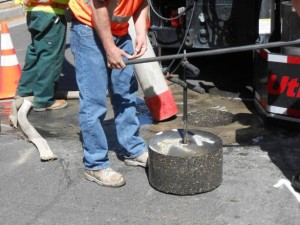
Without good pipe-condition data, water main renewal cannot be optimized. Poor information about the integrity and life expectancy of water mains results in three basic asset management errors:
• Relatively strong mains are often discarded, because they are perceived to be weak
• Renewal of some mains occurs too late, resulting in repairs that were avoidable
• Rehabilitation methods are often inappropriately applied, either wasting money and producing an inferior product, or failing to use the residual strength of the host main and spending too much
In-pipe non-destructive examination (NDE) tools have existed for many years, but these tools are seldom used for small-diameter mains, partly because they are considered too expensive. Many utilities would rather invest in new pipe than in testing old pipe. A large part of the cost of an in-pipe NDE assessment entails inserting and extracting these devices within an operating water system. Moreover, when these NDE tools are used, there are no guidelines for interpreting and applying the data. Instead of using NDE tools, the conditions of mains are usually inferred from indirect data: break history, age, soil conditions, and from limited examinations of the pipes.
Two WaterRF projects are underway, aimed at practical applications of current NDE technology on small mains. Project 4471 proposes to use NDE in a non-disruptive manner to “sample” pipe in a system, then apply the informatoin to infer the condition of similar pipes. Project 4473 goes a step further, proposing to combine the assessment, engineering, and rehabilitation of water mains into a single product delivery.
To read more about this project download the full paper written by Dan Ellison, HDR, Ventura, California; Jonathan Leung, Los Angeles Department of Water and Power, Los Angeles, California; Sam Ariaratnam, Arizona State University, Tempe, Arizona; Andy Romer, AECOM, Orange, California; and Roy Brander, City of Calgary.
Uncategorized
Global resin supplier AOC, LLC collaborated with Clean Water Works Inc. (CWW), an 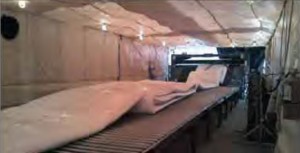 Ottawa-based leader in pipeline rehabilitation, to restore the sewage pipes serving an automobile factory in Windsor, Ontario. Using polyester felt tubing saturated with AOC’s Vipel L010-PPA-33 vinyl ester resin, CWW installed 2,100 ft of cured-in-place-pipe (CIPP), drastically improving the corrosion resistance and durability of the factory’s sewage infrastructure.
Ottawa-based leader in pipeline rehabilitation, to restore the sewage pipes serving an automobile factory in Windsor, Ontario. Using polyester felt tubing saturated with AOC’s Vipel L010-PPA-33 vinyl ester resin, CWW installed 2,100 ft of cured-in-place-pipe (CIPP), drastically improving the corrosion resistance and durability of the factory’s sewage infrastructure.
The automotive plant was closed for two weeks to undertake several projects, including the rehabilitation of old, damaged sewer pipes made of reinforced concrete. AOC delivered more than 175,000 lbs of resin from its Ontario plant for three installations between July 9 and July 15. The first installation was 90 ft long with a 54-in. diameter and used 26,200 lbs of resin. The third was 1,440 ft long with a 54/80-in. transitional tube and used 138,000 lbs of resin.
For more information on AOC Resins visit their website.
Uncategorized
Located on a beautiful peninsula between the Gulf of Mexico and Tampa Bay, the City of St. 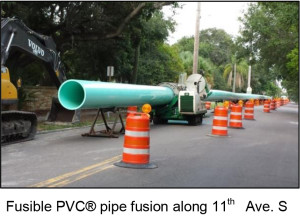 Petersburg is the fourth largest city in Florida. Home to the Tampa Bay Rays MLB team, Salvador Dali Museum, annual Gran Prix Indy Car race, and the St. Pete Pier, the “Sunshine City” is committed to protecting the unique environment of Tampa Bay. The City pioneered wastewater reuse over 40 years ago with the first reclaim water system in the country. To further this legacy, the City recently embarked on a major wastewater pump station and 30-inch pipeline project that would enable the closure of the Albert Whitted Water Reclamation Facility (AWWRF) and transfer the gravity sewage flow to the Southwest Water Reclamation Facility. The City retained multiple consultants to design and bid the project in five parts, four of which dealt withthe nearly seven mile long force main.
Petersburg is the fourth largest city in Florida. Home to the Tampa Bay Rays MLB team, Salvador Dali Museum, annual Gran Prix Indy Car race, and the St. Pete Pier, the “Sunshine City” is committed to protecting the unique environment of Tampa Bay. The City pioneered wastewater reuse over 40 years ago with the first reclaim water system in the country. To further this legacy, the City recently embarked on a major wastewater pump station and 30-inch pipeline project that would enable the closure of the Albert Whitted Water Reclamation Facility (AWWRF) and transfer the gravity sewage flow to the Southwest Water Reclamation Facility. The City retained multiple consultants to design and bid the project in five parts, four of which dealt withthe nearly seven mile long force main.
George F. Young, Inc. (GFYI) was retained to design the force main section nearest the AWWRF, known as Part D. The alignment traversed historic neighborhoods on the outskirts of downtown and, in one area, crossed a vital four lane road to downtown and a major drainage structure. As Toby Spurge, GFYI Engineering VP, explained: “After studying various options to cross these key areas, a single horizontal directional drill of approximately 1,700 linear feet was determined to be the best approach. Bidding contractors were given two HDD pipe options that provided equivalent flow area and pressure rating: 30-inch DR21 Fusible PVC® pipe or 36-inch DR9 HDPE.”
Pipeline Details and Project Summary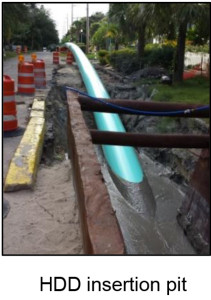
Project: LS85 Albert Whitted Master 30” Force Main, Part D
Length/Pipe Size: 1,700 LF, 30-inch DR 21 FPVC® pipe
Installation: HDD
Owner: City of St Petersburg
Engineer: George F. Young, Inc.
Contractor/Driller: Dallas 1 Corp. / Gator Boring & Trenching, Inc.
Craig Kubiniec, Dallas 1 Project Manager, noted that: “The HDD was a very challenging aspect of the project due to limited space and the desire to minimize public disruption. Minimizing borehole size with Fusible PVC® pipe was a major benefit as drilling conditions were more difficult than expected. UGSI’s assistance with pipe layout and fusion was outstanding.”
Thank you to Underground Solutions for content and photos.
Uncategorized
A city in Alabama discovered severely deteriorated sewer lines, which could fail at any moment, during routine maintenance on a 36-inch trunk sewer line. The city engineer and sewer department determined that the 36-inch trunk line had several upstream and downstream segments with severe weakening due to age. A quick point repair would not alleviate the issue. A permanent repair needed to be completed on several hundred feet of the trunk line quickly and safely. 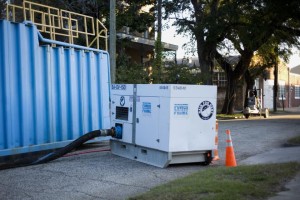
During the sewer main repair, the streets had to remain open and the sewer had to continue flowing so residents would be unaffected and could continue to use their services. The ideal solution for the repair included installing a single cured in place liner for the most deteriorated section of the pipe, requiring the sewer to be bypassed around the section being rehabbed.
The solution to rehabilitate the pipe included relining 750-feet of trunk sewer with a cured in place liner which ran the complete length of the pipe. The main bypass required 2.7 million gallons a day (MGD) for peak dry flows and 11 MGD for peak wet weather conditions. A second bypass was necessary for a 12-inch force main that entered the trunk line in the section that was to be rehabbed. It handled flows of 0.5 MGD for normal conditions and 3.5 MGD for wet conditions. The 1,200-foot bypass included six intersection crossings during the quick one week project.
The contractor chose Rain for Rent because of a long, successful history working together on dozens of pumping projects over the past several years. Relying on prior bypass pumping expertise and by utilizing GPS technology , the contractor, city and Rain for Rent were able to minimize road closures by identifying the order and timeframe to close each street during the initial job walk.
Rain for Rent’s certified fusion technicians fused the HDPE pipe on the project, ensuring a leak-free system. Prior to starting the bypass operation, Rain for Rent confirmed the pipeline’s integrity by hydrostatically testing the entire system.
To alleviate the need to excavate the suction manhole, a single 18-inch HDPE suction stinger was manifolded to four 6-inch DV150i sound attenuated pumps. These pumps were then manifolded through gate valves into a single 18-inch HDPE discharge pipe that ran the length of the project.
At each intersection, an 18-inch steel road crossing was placed to allow for traffic to continue without disturbance. Each road crossing was smoothed out with cold patch asphalt to minimize the bump for traffic flow. Sound attenuated pumps ran 24/7 during the installation of the liners, keeping the operation quiet.
To give the 12-inch force main bypass enough head pressure to break into the existing flow of the 18-inch sewer line bypass, the project utilized a pump drawing water from a 21,000 gallon reservoir tank to pressurize the system. Because the tank is portable and only 8-ft wide, cross street traffic continued to flow. The contractor installed a temporary connection at the force main and flanged high pressure hose was used to plumb the force main into the tank. An additional six-inch DV150i sound attenuated pump was used to move the liquid from the tank through a gate valve into the 18-inch HDPE bypass line.
The CIPP contractor installed a direct inversion liner to repair the aging sewer lines. This solution was the fastest, least obtrusive solution to rehabilitate the lines, quickly getting the pipelines back into service.
The city averted an emergency situation by taking action when the initial damage was discovered, collaborating with the CIPP contractor and Rain for Rent, completing the project within the one week timeframe. The 200,000 residents of the city were unaffected by the bypass. With a total of approximately 15 million gallons pumped, the bypass was completed safely without incident during the nearly 210 man hours worked during set up and tear down on the project with an additional 96 hours for 24 hour-a-day pump watch.
Written by Brian Brandstetter. Photo courtesy of Rain for Rent.
Uncategorized
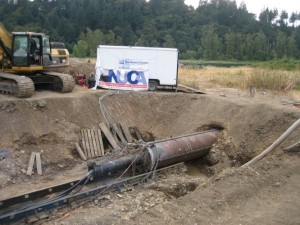 In November, 2013 Armin W. Stuedlein, PhD, PE and Tadesse Meskele of the Geotechnical Engineering Group, School of Civil and Construction Engineering at Oregon State University completed a research project on pipe ramming installations for the Oregon Department of Transportation and the Federal Highway Administration.
In November, 2013 Armin W. Stuedlein, PhD, PE and Tadesse Meskele of the Geotechnical Engineering Group, School of Civil and Construction Engineering at Oregon State University completed a research project on pipe ramming installations for the Oregon Department of Transportation and the Federal Highway Administration.
Background: Culverts are an essential component of roadway drainage systems that transport storm runoff and stream channels from one side of a road to the other. The majority of culverts installed in the 1950s and 1960s are reaching the end of their functional lives and need replacement due to structural deterioration, scour, corrosion, erosion, separation, or increased hydraulic requirements.
The traditional open cut method is the most widely used method for installation or rehabilitation of underground pipelines, conduits, and culverts. However, the open-cut method requires time-consuming excavation, installation and back-filling, which can impose an adverse impact on the daily life of society by creating road or rail closures, traffic delays, detours, loss of access to homes and businesses, and undesirable noises (Ariaratnam et al. 2006). Thus, engineers and contractors are gradually abandoning open trench cutting and embracing trenchless methods of pipe installation. These trenchless methods can mitigate many of the logistical issues associated with traditional approaches. In particular, pipe ramming, which is a simple non-steerable trenchless construction technique, is becoming an emerging method of pipe installation, because it allows installation of casings in soils with large cobbles and boulders, which are ground conditions that may pose greater difficulty to other trenchless techniques. Pipe ramming is also a commonly chosen technique for shallow pipe or culvert installation under roads and railways, where other trenchless methods could cause unacceptable ground settlement or heave.
Need for this Research: Despite the growing popularity and experience with pipe ramming, there is surprisingly little technical guidance available for engineers to plan pipe ramming installations appropriately. Stuedlein and Meskele presented a preliminary, baseline engineering framework for the design of pipe ramming installations.
Objectives of the Study: The main objective of this research is to study the mechanics of pipe ramming and to develop a rational engineering framework for the optimal design and specification of pipe ramming installations.
To learn more about this research and to read the full report click here.
Thank you to School of Civil and Construction Engineering, Oregon State University for providing this content and photo. Photo info: Pipe ramming performed at an experimental test site for the OSU research project. This test ram was made possible in part by members of the NUCA of Southwest Washington and Oregon.
Uncategorized
 Aegion Corporation announced that its subsidiary, Insituform Technologies, LLC has been awarded two contracts with a combined value of $7.4 million from Metro Water Services in Nashville, Tennessee.
Aegion Corporation announced that its subsidiary, Insituform Technologies, LLC has been awarded two contracts with a combined value of $7.4 million from Metro Water Services in Nashville, Tennessee.
Beginning in early 2014, Insituform crews will install Insituform® cured-in-place pipe (CIPP) in over 13 miles of 8- to 18-inch wastewater pipelines, primarily in residential areas throughout Nashville. Insituform will oversee local subcontractors and small businesses that will perform manhole rehabilitation, concrete and paving work, site preparation and restoration and lateral lining.
Jeff Kowal, Vice President and General Manager of Insituform’s East Region, said, “Metro Water Services is implementing its 11-year Clean Water Nashville Overflow Abatement Program to improve its wastewater system infrastructure. These improvements will provide lasting benefits for future generations and provide a clean, healthier environment for the citizens of the greater Nashville area. This is a significant undertaking and we are proud to work with MWS on its efforts to ensure local residents realize the full benefit of these rehabilitation projects. We will continue to pursue additional projects that are planned by MWS in an effort to support its program.”
The projects are expected to be completed in 2014.
Thank you to Aegion and Insituform for providing this content and photo.







